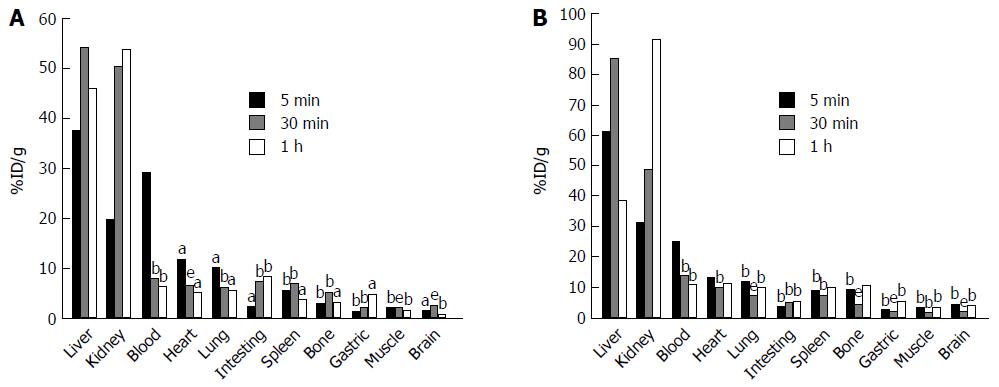Copyright
©The Author(s) 2017.
World J Gastroenterol. Jun 21, 2017; 23(23): 4278-4284
Published online Jun 21, 2017. doi: 10.3748/wjg.v23.i23.4278
Published online Jun 21, 2017. doi: 10.3748/wjg.v23.i23.4278
Figure 1 [18F]FNGA distribution in both control and fibrosis mice at various time points.
Relative radioactivity levels are shown at various time points from organs of control mice (n = 21) (A) and CCl4-induced fibrosis mice (n = 23) (B). bP < 0.01 vs Liver, aP < 0.05 vs Liver, eP < 0.001 vs Liver. [18F]FNGA: 18F-labeled neogalactosylalbumin.
Figure 2 Positron emission tomography images from a scanning of control mouse in a 30-min period.
A: Each scan took 2 min followed by 1 min break; B: Dynamic radioactivity curves from region of interest for liver and heart from positron emission tomography scanning.
Figure 3 Comparison of the [18F]FNGA positron emission tomography scan parameters between fibrosis mice (n = 10) and control mice (n = 8).
A: The LUA was significantly lower in fibrosis liver than that in normal liver; B: The Tp took significantly longer in fibrosis liver to reach a peak than in the normal liver; C: The LUR of fibrosis liver was significantly slower than that of the controls. aP < 0.05, bP < 0.01 vs fibrosis. [18F]FNGA: 18F-labeled neogalactosylalbumin; LUA: Liver uptake capacity; Tp: Peak time; LUR: Liver uptake rate.
- Citation: Du SD, Li SH, Jin B, Zhu ZH, Dang YH, Xing HQ, Li F, Wang XB, Lu X, Sang XT, Yang HY, Zhong SX, Mao YL. Potential application of neogalactosylalbumin in positron emission tomography evaluation of liver function. World J Gastroenterol 2017; 23(23): 4278-4284
- URL: https://www.wjgnet.com/1007-9327/full/v23/i23/4278.htm
- DOI: https://dx.doi.org/10.3748/wjg.v23.i23.4278











